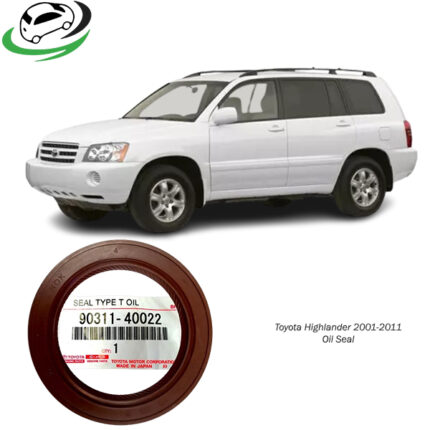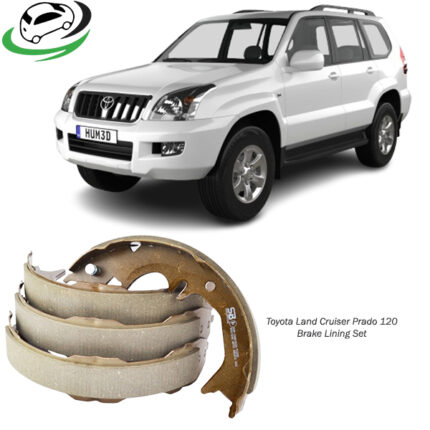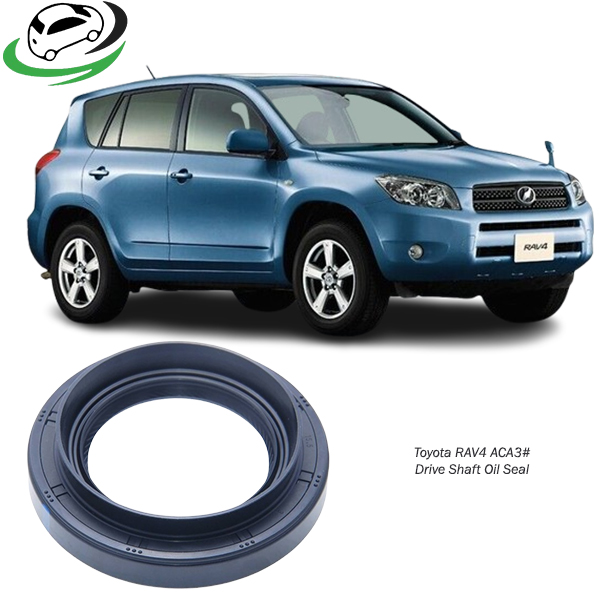-25%
Get Toyota Rav4 ACA3# Front Drive Shaft Oil Seal 90311-40031 in Kenya
The front drive shaft oil seal is a critical component in the drivetrain system of a vehicle. It plays a vital role in maintaining the efficiency and functionality of the front axle assembly by preventing lubricant leaks and protecting against contamination. This comprehensive guide will explore the purpose, design, types, benefits, installation, maintenance, and troubleshooting of front drive shaft oil seals.
1. Purpose of the Front Drive Shaft Oil Seal
The front drive shaft oil seal is primarily designed to perform the following functions:
a. Preventing Lubricant Leakage
One of the primary functions of the front drive shaft oil seal is to prevent the transmission fluid or differential oil from leaking out of the drive shaft assembly. This is crucial for maintaining proper lubrication within the drivetrain, which reduces friction and wear on moving components.
b. Contaminant Protection
The oil seal acts as a barrier, preventing dirt, debris, and moisture from entering the drivetrain system. Contaminants can significantly impair the functionality of the drivetrain and lead to premature wear or failure of internal components.
c. Maintaining Pressure
The oil seal helps maintain the required pressure within the drivetrain system. This is essential for optimal performance, ensuring that the lubrication system functions effectively and efficiently.
2. Design and Construction of Front Drive Shaft Oil Seals
Understanding the design and construction of front drive shaft oil seals is important for appreciating their functionality and role in vehicle performance.
a. Material Composition
Front drive shaft oil seals are typically made from a variety of materials, including:
- Nitrile Rubber (NBR): This is the most common material used for oil seals due to its excellent resistance to oil, heat, and wear. It offers flexibility and durability, making it suitable for various applications.
- Fluoroelastomer (FKM): This material is often used in high-temperature applications due to its superior resistance to heat and chemicals. It is ideal for performance vehicles or heavy-duty applications where temperatures can exceed normal limits.
- Polyurethane: Known for its high durability and resistance to abrasion, polyurethane oil seals are suitable for heavy-duty applications that require enhanced strength.
b. Design Features
- Shape and Size: Front drive shaft oil seals are designed in various shapes and sizes to accommodate different vehicle specifications. The correct dimensions are essential for achieving a proper seal.
- Seal Lip: The seal lip is the critical part of the oil seal that makes contact with the drive shaft. It is designed to be flexible to create a tight seal while allowing for any slight movement of the shaft.
- Spring: Many front drive shaft oil seals feature a metal or rubber spring that exerts additional tension on the seal lip. This ensures that the seal maintains contact with the shaft, effectively preventing leaks.
- Outer Diameter: The outer diameter of the oil seal is designed to fit snugly into the housing or bore of the drive shaft assembly, providing a secure installation that helps prevent leaks.
3. Types of Front Drive Shaft Oil Seals
There are several types of front drive shaft oil seals, each designed for specific applications. Some common types include:
a. Single Lip Oil Seals
Single lip oil seals are the most common type used in front drive shaft applications. They consist of a single sealing lip that makes contact with the shaft, providing an effective barrier against lubricant leakage and contaminants.
b. Double Lip Oil Seals
Double lip oil seals have two sealing lips, offering enhanced protection against leakage and contamination. They are often used in high-performance or heavy-duty applications where additional sealing capacity is required.
c. Radial Oil Seals
Radial oil seals are specifically designed to seal around rotating shafts. They are commonly used in automotive applications, including front drive shafts, to prevent lubricant loss and protect against external contaminants.
4. Benefits of Using Front Drive Shaft Oil Seals
Utilizing front drive shaft oil seals provides numerous advantages, including:
a. Leak Prevention
Front drive shaft oil seals effectively prevent leakage of lubricant, ensuring that the drivetrain remains adequately lubricated for optimal performance.
b. Contaminant Protection
By keeping contaminants out, oil seals protect sensitive internal components from damage. This helps to prolong the lifespan of the drivetrain and reduces maintenance needs.
c. Enhanced Efficiency
Proper sealing helps maintain optimal lubrication, reducing friction and improving the overall efficiency of the drivetrain system.
d. Cost Savings
Preventing leaks and reducing wear on internal components can lead to lower maintenance and repair costs. Regularly replacing worn seals can save significant expenses in the long run.
5. Installation of Front Drive Shaft Oil Seals
Correct installation of front drive shaft oil seals is crucial for ensuring their effectiveness and longevity. Here’s a step-by-step guide for installing front drive shaft oil seals:
a. Tools Required
Before starting the installation, gather the necessary tools:
- Seal driver or installer tool
- Rubber mallet or hammer
- Cleaning supplies (solvent, rag)
- Safety goggles and gloves
b. Preparation
- Safety First: Ensure the vehicle is powered down and secure. Wear safety goggles and gloves for protection.
- Remove Old Seal: If replacing an old oil seal, carefully remove it using a seal puller or flathead screwdriver. Be cautious not to damage the surrounding components.
c. Clean the Area
Before installing the new seal, thoroughly clean the sealing surface and the bore where the seal will be installed. Remove any dirt, debris, or old sealant to ensure a proper fit.
d. Lubricate the Seal Lip
Apply a thin layer of oil or grease to the lip of the new front drive shaft oil seal. This lubrication helps the seal slide into place without damage and aids in creating a tight seal.
e. Install the New Oil Seal
- Position the Seal: Align the oil seal with the bore and gently press it into place. Ensure the seal is positioned evenly and flush with the surrounding surface.
- Use a Seal Driver: If available, use a seal driver or installer tool to press the seal into place evenly. Tap gently with a rubber mallet to ensure it is seated properly.
f. Reassemble Components
After the oil seal is securely installed, reassemble any components that were removed during the installation process. Ensure all fasteners are tightened to the manufacturer’s specifications.
6. Maintenance Tips for Front Drive Shaft Oil Seals
Regular maintenance of front drive shaft oil seals is essential for ensuring their longevity and effectiveness. Here are some maintenance tips:
a. Regular Inspections
Conduct regular inspections of front drive shaft oil seals for signs of wear, damage, or leakage. Early detection of issues can help prevent more significant problems.
b. Monitor Fluid Levels
Keep an eye on lubricant levels in the drivetrain system. Low fluid levels can lead to increased wear on the oil seal and other components.
c. Listen for Noises
Be attentive to any unusual noises from the drivetrain, such as grinding or whining sounds, which may indicate issues with the oil seal or other components.
d. Replace Worn Seals Promptly
If inspections reveal significant wear or damage, replace the oil seal promptly to prevent lubricant leaks and potential damage to internal components.
e. Use Genuine Parts
When replacing front drive shaft oil seals, always opt for genuine or high-quality aftermarket parts to ensure compatibility and performance.
7. Signs of Wear and When to Replace Front Drive Shaft Oil Seals
Recognizing the signs of wear is crucial for maintaining the effectiveness of front drive shaft oil seals. Common indicators that an oil seal may need replacement include:
a. Fluid Leaks
The most apparent sign of a failing front drive shaft oil seal is the presence of fluid leaks. If you notice oil pooling beneath the vehicle or around the drive shaft, it may indicate a compromised seal.
b. Contaminated Lubricant
If the lubricant appears dirty or contaminated, it may suggest that the oil seal is allowing debris to enter the system. Inspect the seal and replace it if necessary.
c. Increased Noise
If the drivetrain produces increased noise, such as grinding or rattling sounds, it may indicate a problem with the oil seal or related components.
d. Visual Damage
Inspect the front drive shaft oil seal for any visible signs of wear, such as cracks, tears, or deformation. If the seal appears damaged, it should be replaced immediately.
e. Performance Issues
If the vehicle exhibits reduced performance or efficiency, it may be due to a failing oil seal. Monitor performance and conduct inspections as needed.
Conclusion
The front drive shaft oil seal is an essential component in the drivetrain system, serving to prevent lubricant leakage, protect against contamination, and maintain internal pressure. Understanding its design, types, benefits, installation, maintenance, and signs of wear can help vehicle owners and operators make informed decisions about their equipment. Regular inspections, timely replacements, and the use of genuine parts are vital for ensuring the optimal performance and longevity of front drive shaft oil seals. By prioritizing the maintenance of these seals, vehicle owners can enhance overall operational efficiency and prolong the lifespan of their drivetrains, leading to significant cost savings and reduced downtime.
Follow us on Facebook for more parts.




Reviews
Clear filtersThere are no reviews yet.